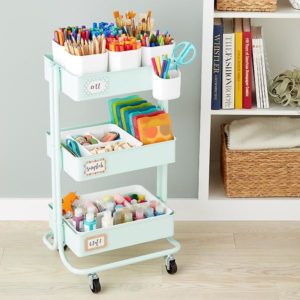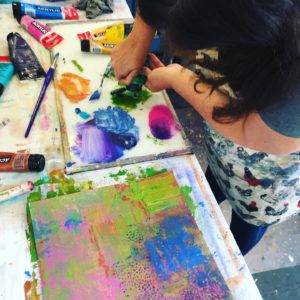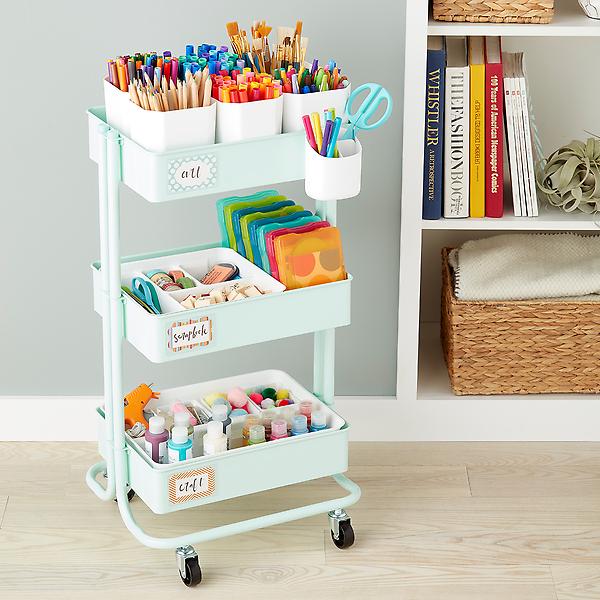What to Do When You Don’t Feel Like Painting
Sometimes you want to be in your studio or do something creative, but you don’t fee like painting. So what should you do? It’s a good idea to do activities that support your painting process, without actually starting on a new canvas. I am going to give you several ideas for what to do when you want to support your creative process, but don’t feel like painting.
1. Organize Your Studio/Work Area
One suggestion I have for supporting your creative process without painting is to organize your work area. Who doesn’t need some organization in their studio/art work area? Does your supply storage area need some organizing? Be sure to have your supplies organized so you can easily access them; this will facilitate your painting process and make it more enjoyable.
Art Carts
Depending on your space, you might consider some furniture to help your organization. I love having a rolling art cart. You can find these in Michael’s, Ikea and many other places these days. I have two, and I love being able to wheel them around if I need to.
My carts also keep my paints easily visible, organized and in one place. This was a big improvement for me from when I used to put my paints in boxes under my art table. It also made it easier for me to paint because they were already out, and contained nicely in one place.

Art carts are a great way to efficiently store all of your painting supplies.
How I Organize My Cart
Cart 1: For my painting mediums (yes, I have a lot). If you don’t have enough mediums to fill a whole cart, you could also put varnishes, glues, and painting tools on this cart.
Cart 2: All of my paints. The top shelf is for colors, the second shelf is for white, black, browns, metallics, and the bottom shelf is for any paint colors I mixed myself (see #3 below).
2. Clean Your Work Area
Another way I suggest for supporting your creativity is to clean and refresh your studio. I love to make a mess like anyone else. I get paint splatters on walls and floors, drop ripped collage paper under my art table, and my collection of stuff grows. Besides the usual cleaning and vacuuming one might do in a studio, I’d like to suggest you take it a step further.
When I take out white wall paint and spot paint the walls so the splatters are gone, I feel renewed. Another thing that helps to refresh your painting space is to get a new cloth drop cloth and get rid of the one caked with paint. These are minor things, but they make a big difference in terms of my head space and clarity for when I’m ready to start a new piece.
3. Mix Paint Colors and Put in Containers
Another great way to spend time in the studio but not actually paint is to mix colors for the next session. Maybe there’s a color scheme you want to try out, or you have favorite colors you always run out of. Regardless, spending time mixing colors and putting them in sealable containers is a great way to be creative and get a head start on your next piece.
You can purchase plastic containers with lids from the art store, but for the very best deal I’d recommend purchasing specimen containers. I know it sounds weird, but they work like a charm and are affordable.
I bought a 100 pack for a great deal, and it gives me enough containers to save paint after a session so it doesn’t go to waste. You can also use these containers to make your own pour paint medium or to make fluid paints.
4. Search Online for Inspiration Images
Another way to prepare for your next painting is to find inspiration. Searching for abstract paintings online is a great way to get inspired and collect ideas. Of course you wouldn’t want to copy anything that you find, but I have gotten ideas for color schemes, marks, and composition by looking at paintings I love.
I usually google search “abstract paintings” or “contemporary abstract paintings” and see what comes up. Pinterest is a great place to do this kind of research if you have the app, because then you can save your images in folders.
If it’s easy to do so, an even better idea would be to go to a local gallery or museum and look at paintings in person. This takes more time, but seeing a piece in person allows you to observe it carefully. I love to try to figure out how a piece was made, and many gallerists will share the artist’s process if you ask.
5. Search Your Home for Uncommon Painting Tools
I love to periodically search for uncommon tools on days I don’t want to be working in the studio. This is a scavenger hunt of sorts. Go around your house–the medicine cabinet, basement, attic, backyard, etc, and try to find things that could be used to paint with, or could be added into your paint. An example might be that you find a house painting roller in the basement, or some gauze that could be collaged into your painting. Or you might find old photos or papers that might be an inspiration.
Keep an open mind as you do this scavenger hunt, and remember that acrylic dries to a plastic and can encase things quite well. Small to medium sized objects such as coins can be embedded into paint, but if your object is larger or heavier, then use Golden Molding Paste or another heavy bodied medium that can stand up to substantial objects.
6. Take Stock of Your Current Paintings

Painting over old pieces is a great way to revive unfinished paintings.
Another thing to do if you don’t feel like painting is to take stock of your paintings. If you have a lot of paintings lying around, it might be time to take stock. Try to determine which ones are totally finished, and get those hanging on the wall or give them as gifts. If you have many finished paintings that are just sitting around, I might question whether they are actually done.
I have a few paintings that are “finished,” but I don’t LOVE them. Sometimes they sit around for months because I’m worried about painting over them. However, in my heart I know they aren’t great paintings, which means I should just go ahead and work over them.
Should You Paint Over Old Paintings?
It’s not a bad idea to wait before painting over pieces that you think are finished. About fifteen years ago I painted over a piece that was already published on my website, and a potential collector reached out to buy it! That was frustrating, but I didn’t love the painting and probably wouldn’t have been thrilled to have it out in the world. This has never happened since, by the way. However, this was a good lesson in being careful about painting over finished paintings, and to this day, I am more mindful about this.
As for the paintings that are definitely not finished, put those in a pile and make a point to work over them. Part of my process is to cover old paintings with one color with a dry brush technique so that I still retain some of the remaining layers, and I recommend trying this. Regardless, try to make bold moves when painting over old or unfinished paintings, because when it’s this early in your painting process you don’t have a whole lot to lose.
Conclusion
In conclusion, take time to do activities that support your painting process. Cleaning and organizing the studio, exploring your house for new tools, and looking at paintings that inspire you are all useful activities that will support your painting process. Doing these things will also refresh you and prepare you for your next painting session.
Do you have ideas for what to do when you don’t feel like painting? Comment below!
ABOUT ANDREA CERMANSKI
I am an artist out of Santa Fe, New Mexico who has been painting for almost 30 years. I love to teach first-timers as well as experienced painters who need a creative reboot. My work has been displayed in several galleries around the country, and I have a Bachelor’s in Art History, a Master’s in Art Education, and had my work in a show juried by Judy Chicago. The idea of getting more people painting makes me light up as I want to inspire more people to express their creative selves and tap into a place of joy and calm.
WANT TO LEARN MORE?
- Subscribe and get a FREE PDF explaining How to Use My 5 Favorite Mediums
- Check out My Online Painting Course & Group Coaching Programs
- Read More Painting Tips Blog Posts
- Learn About 3-Day Painting Retreats in Santa Fe
- Check out My Paintings & Art Prints for Sale
- Follow me on Youtube, Instagram, or Pinterest

Hello. All of these activities are useful and fun. I especially like google and Pinterest to see new ideas. I look for things that give me an energy boost. That is a sure-fire way to get the juices going.
I love the scavenger hunt idea. I have a special drawer with those things in it. There are flattened sponges you can cut I to shapes. When dipped in water, they expand and I use them to stamp. They come in handy at Christmas for mini-paintings or cards.
Not to get too off-track, going to museums is worth the time. I am lucky i live within traveling distance for the Art Institute of Chicago. A world-class museum.is just a train ride away.
Who doesn’t need to tidy? Thanks for all the ideas, Andrea.